

Compact Muon Solenoid
LHC, CERN
| CMS-PAS-FSQ-16-008 | ||
| Measurement of the underlying event using the Drell-Yan process in proton-proton collisions at √s= 13 TeV | ||
| CMS Collaboration | ||
| December 2016 | ||
| Abstract: This article presents a measurement of the underlying event activity, in proton-proton collisions at a centre-of-mass energy of 13 TeV, performed using inclusive Z-boson events (qq→μ+μ−) collected by the CMS experiment at the Large Hadron Collider. The analyzed data corresponds to an integrated luminosity of 2.1 fb−1. The Underlying event activity is quantified in terms of charged particle multiplicity and their scalar pT sum in different topological regions defined with respect to the azimuthal direction of the two muons coming from the decay of the Z-boson. The distributions are unfolded to stable charged-particle level and are compared with prediction from various models at a centre-of-mass energy of 13 TeV, as well as with measurements at a centre-of-mass energy of 1.96 TeV and 7 TeV by the CDF and CMS experiments. | ||
|
Links:
CDS record (PDF) ;
inSPIRE record ;
CADI line (restricted) ;
These preliminary results are superseded in this paper, JHEP 07 (2018) 032. The superseded preliminary plots can be found here. |
||
| Figures | |

png pdf |
Figure 1:
Unfolded distribution of (a) particle density and (b) ΣpT density as a function of pTμμ in the towards, transverse, and away regions. Error bars represent the statistical and systematic uncertainties added in quadrature. |
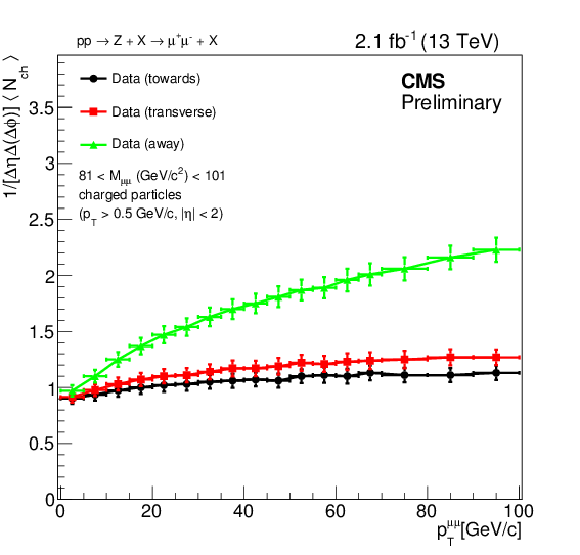
png pdf |
Figure 1-a:
Unfolded distribution of particle density as a function of pTμμ in the towards, transverse, and away regions. Error bars represent the statistical and systematic uncertainties added in quadrature. |
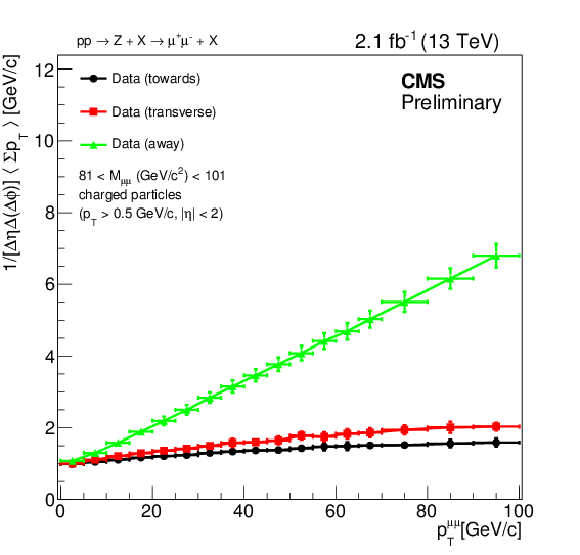
png pdf |
Figure 1-b:
Unfolded distribution of ΣpT density as a function of pTμμ in the towards, transverse, and away regions. Error bars represent the statistical and systematic uncertainties added in quadrature. |
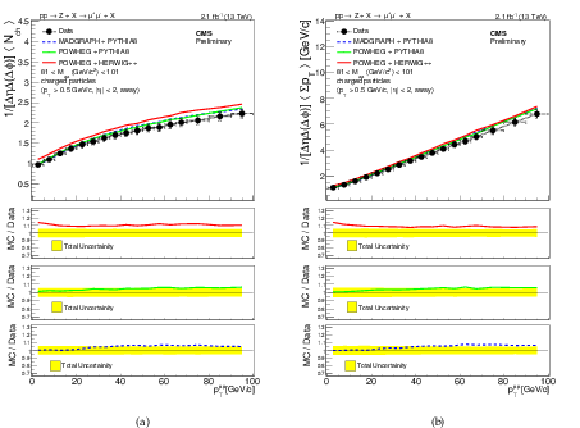
png pdf |
Figure 2:
Comparison of unfolded distributions of (a) particle density and (b) ΣpT density as a function pTμμwith various models in the away region. The predictions of madgraph + pythia8, powheg + pythia8, and powheg + herwig++ are also overlayed. The bottom panel of each plot reports the ratio of the simulation to the measured distribution. Error band in the bottom panel represent the statistical and systematic uncertainties added in quadrature. |
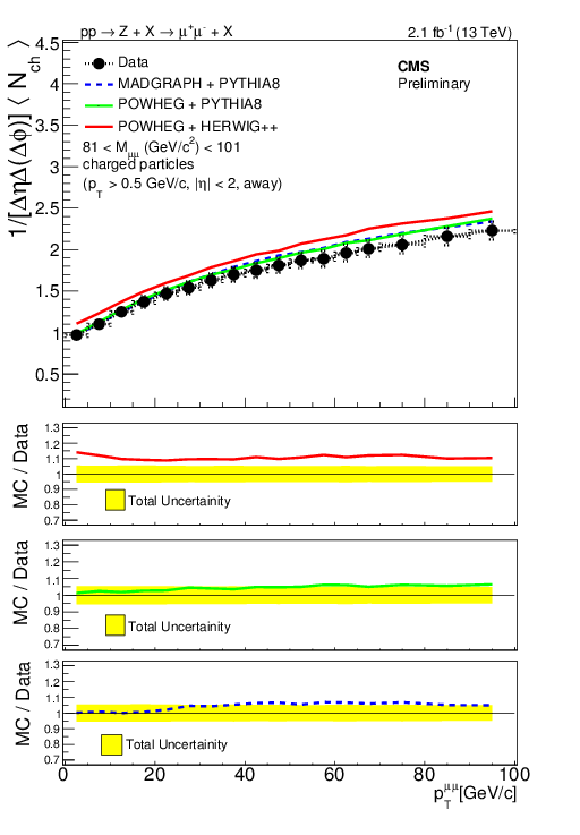
png pdf |
Figure 2-a:
Comparison of unfolded distributions of particle density as a function pTμμwith various models in the away region. The predictions of madgraph + pythia8, powheg + pythia8, and powheg + herwig++ are also overlayed. The bottom panel of each plot reports the ratio of the simulation to the measured distribution. Error band in the bottom panel represent the statistical and systematic uncertainties added in quadrature. |

png pdf |
Figure 2-b:
Comparison of unfolded distributions of ΣpT density as a function pTμμwith various models in the away region. The predictions of madgraph + pythia8, powheg + pythia8, and powheg + herwig++ are also overlayed. The bottom panel of each plot reports the ratio of the simulation to the measured distribution. Error band in the bottom panel represent the statistical and systematic uncertainties added in quadrature. |
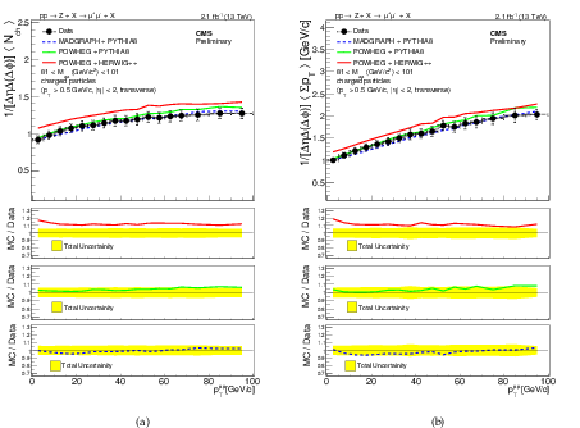
png pdf |
Figure 3:
Comparison of unfolded distributions of (a) particle density and (b) ΣpT density as a function pTμμwith various models in the transverse region. The predictions of madgraph + pythia8, powheg + pythia8, and powheg + herwig++ are also overlayed. The bottom panel of each plot reports the ratio of the simulation to the measured distribution. Error band in the bottom panel represent the statistical and systematic uncertainties added in quadrature. |

png pdf |
Figure 3-a:
Comparison of unfolded distributions of particle density density as a function pTμμwith various models in the transverse region. The predictions of madgraph + pythia8, powheg + pythia8, and powheg + herwig++ are also overlayed. The bottom panel of each plot reports the ratio of the simulation to the measured distribution. Error band in the bottom panel represent the statistical and systematic uncertainties added in quadrature. |

png pdf |
Figure 3-b:
Comparison of unfolded distributions of ΣpT density as a function pTμμwith various models in the transverse region. The predictions of madgraph + pythia8, powheg + pythia8, and powheg + herwig++ are also overlayed. The bottom panel of each plot reports the ratio of the simulation to the measured distribution. Error band in the bottom panel represent the statistical and systematic uncertainties added in quadrature. |
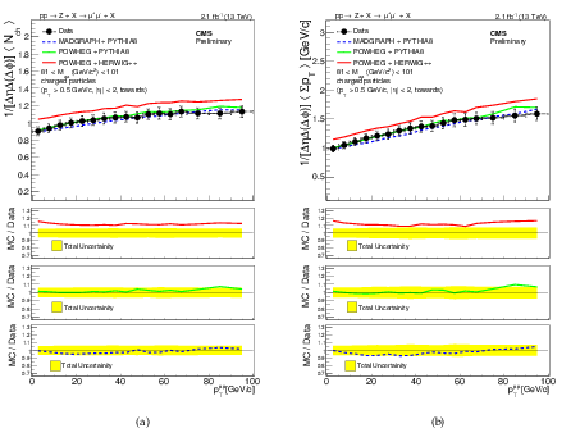
png pdf |
Figure 4:
Comparison of unfolded distributions of (a) particle density and (b) ΣpT density as a function pTμμwith various models in the towards region. The predictions of madgraph + pythia8, powheg + pythia8, and powheg + herwig++ are also overlayed. The bottom panel of each plot reports the ratio of the simulation to the measured distribution. Error band in the bottom panel represent the statistical and systematic uncertainties added in quadrature. |

png pdf |
Figure 4-a:
Comparison of unfolded distributions of particle density as a function pTμμwith various models in the towards region. The predictions of madgraph + pythia8, powheg + pythia8, and powheg + herwig++ are also overlayed. The bottom panel of each plot reports the ratio of the simulation to the measured distribution. Error band in the bottom panel represent the statistical and systematic uncertainties added in quadrature. |
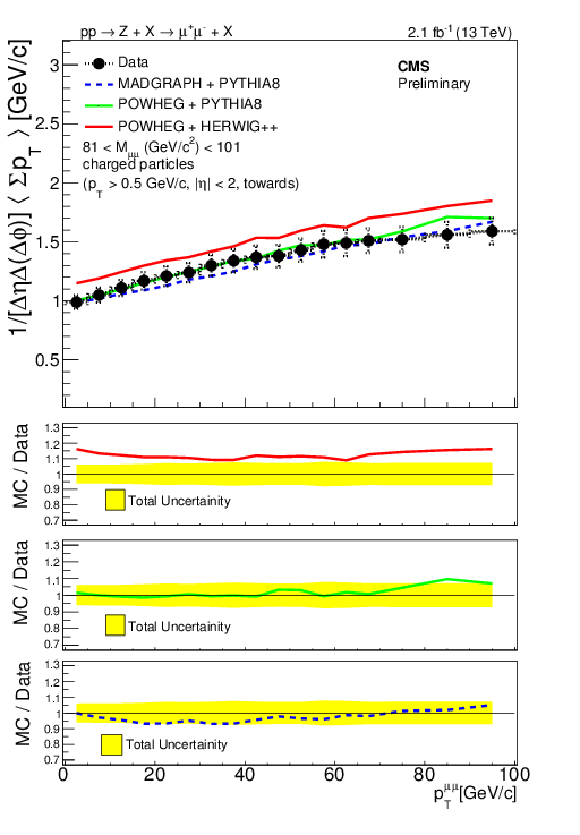
png pdf |
Figure 4-b:
Comparison of unfolded distributions of ΣpT density as a function pTμμwith various models in the towards region. The predictions of madgraph + pythia8, powheg + pythia8, and powheg + herwig++ are also overlayed. The bottom panel of each plot reports the ratio of the simulation to the measured distribution. Error band in the bottom panel represent the statistical and systematic uncertainties added in quadrature. |
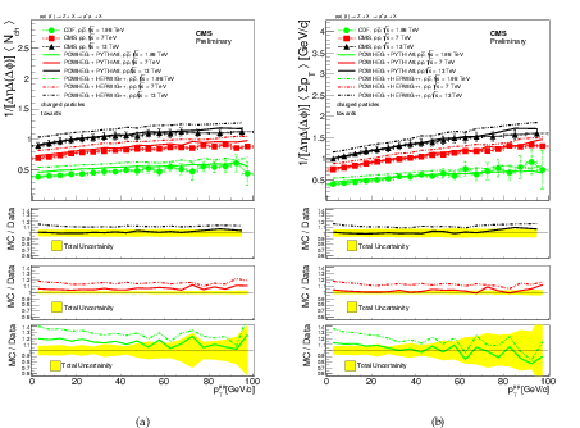
png pdf |
Figure 5:
Comparison of the UE activity measured at √s= 13 TeV with the measurements at 7 and 1.96 TeV, by the CMS and CDF experiments, for (a) particle density in the towards region, (b) ΣpT density in the towards region as a function of pTμμ. The measured data distributions are also compared with predictions of powheg + pythia8 and powheg + herwig++. The bottom panel of each plot reports the ratio of model predictions to the measurements. Error band in the bottom panel represent the statistical and systematic uncertainties added in quadrature. |
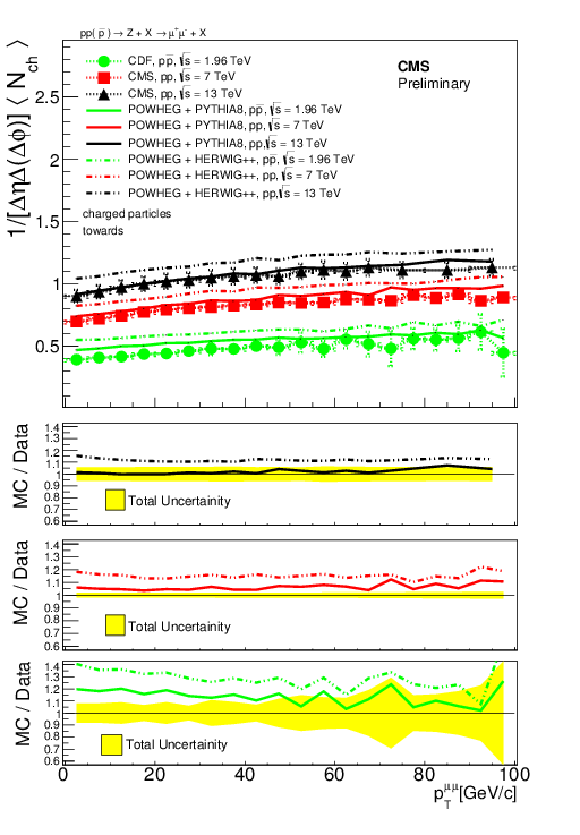
png pdf |
Figure 5-a:
Comparison of the UE activity measured at √s= 13 TeV with the measurements at 7 and 1.96 TeV, by the CMS and CDF experiments, for particle density in the towards region as a function of pTμμ. The measured data distributions are also compared with predictions of powheg + pythia8 and powheg + herwig++. The bottom panel of each plot reports the ratio of model predictions to the measurements. Error band in the bottom panel represent the statistical and systematic uncertainties added in quadrature. |
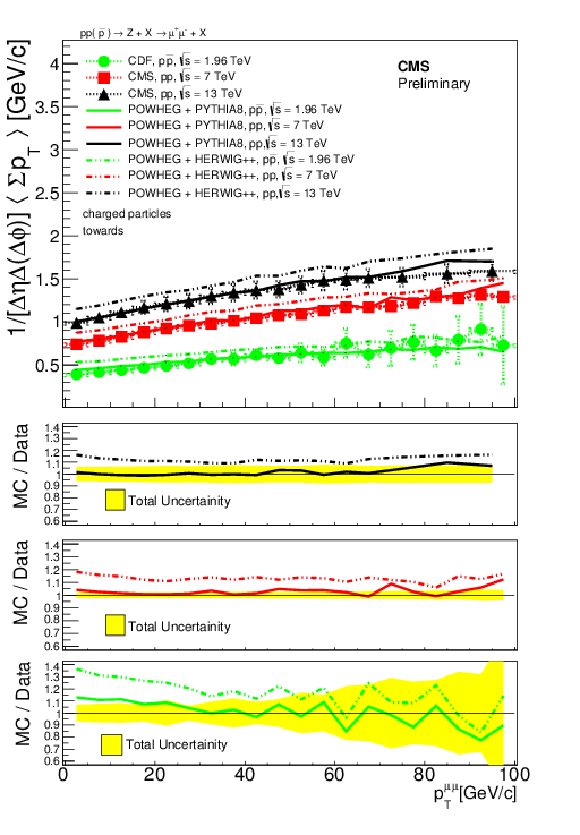
png pdf |
Figure 5-b:
Comparison of the UE activity measured at √s= 13 TeV with the measurements at 7 and 1.96 TeV, by the CMS and CDF experiments, for ΣpT density in the towards region as a function of pTμμ. The measured data distributions are also compared with predictions of powheg + pythia8 and powheg + herwig++. The bottom panel of each plot reports the ratio of model predictions to the measurements. Error band in the bottom panel represent the statistical and systematic uncertainties added in quadrature. |
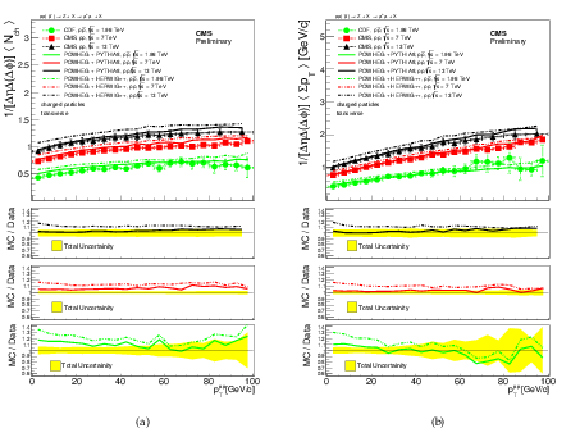
png pdf |
Figure 6:
Comparison of UE activity measured at √s= 13 TeV with the measurements at 7 and 1.96 TeV, by CMS and CDF experiments, for (a) particle density in the transverse region, and (b) ΣpT density in the transverse region. The measured data distributions are also compared with predictions of powheg + pythia8 and powheg + herwig++. The bottom panel of each plot reports the ratio of model predictions to the measurements. Error band in the bottom panel represent the statistical and systematic uncertainties added in quadrature. |
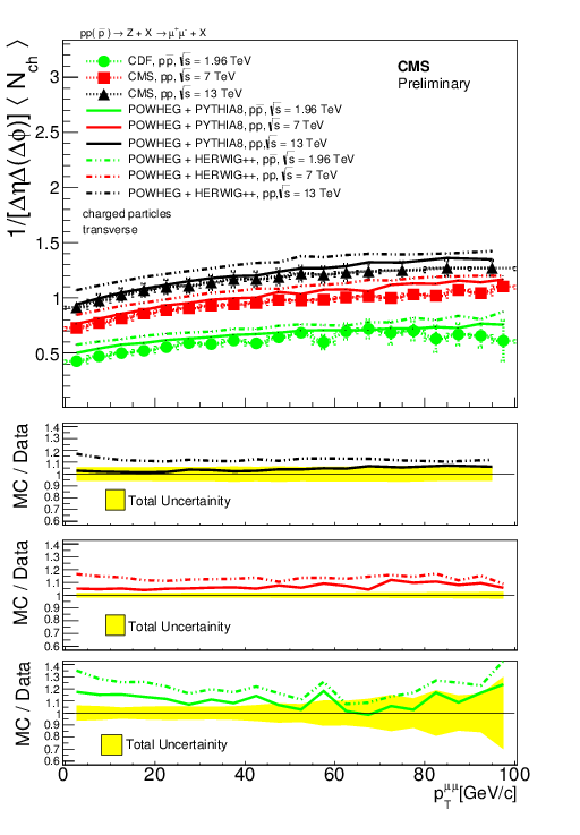
png pdf |
Figure 6-a:
Comparison of UE activity measured at √s= 13 TeV with the measurements at 7 and 1.96 TeV, by CMS and CDF experiments, for particle density in the transverse region. The measured data distributions are also compared with predictions of powheg + pythia8 and powheg + herwig++. The bottom panel of each plot reports the ratio of model predictions to the measurements. Error band in the bottom panel represent the statistical and systematic uncertainties added in quadrature. |
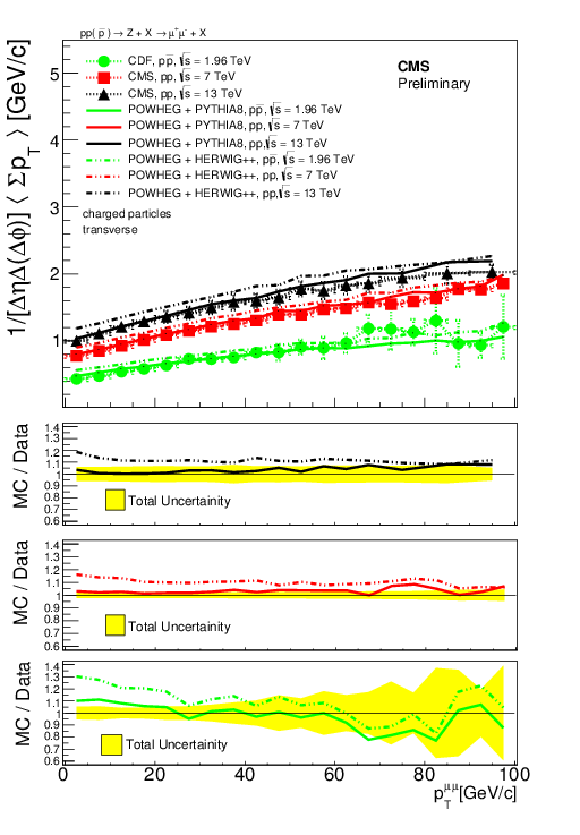
png pdf |
Figure 6-b:
Comparison of UE activity measured at √s= 13 TeV with the measurements at 7 and 1.96 TeV, by CMS and CDF experiments, for ΣpT density in the transverse region. The measured data distributions are also compared with predictions of powheg + pythia8 and powheg + herwig++. The bottom panel of each plot reports the ratio of model predictions to the measurements. Error band in the bottom panel represent the statistical and systematic uncertainties added in quadrature. |
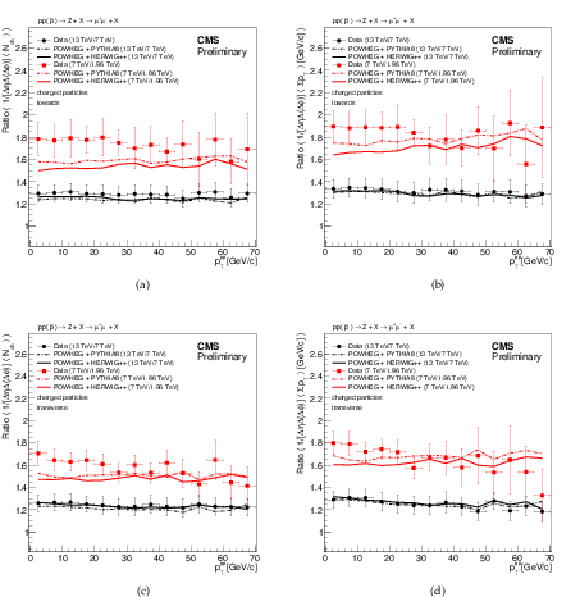
png pdf |
Figure 7:
Comparison of the UE activity measured at √s= 13 TeV with the measurements at 7 and 1.96 TeV, by the CMS and CDF experiments, in the towards (top) and transverse (bottom) regions. Figures (a) and (c) show the particle density , whereas figures (b) and (d) show the ΣpT density as a function of pTμμ. The measured data distributions are also compared with predictions of powheg + pythia8 and powheg + herwig++. Error bars represent the statistical and systematic uncertainties added in quadrature. |

png pdf |
Figure 7-a:
Comparison of the UE activity measured at √s= 13 TeV with the measurements at 7 and 1.96 TeV, by the CMS and CDF experiments, in the towards region. The Figure shows the particle density as a function of pTμμ. The measured data distributions are also compared with predictions of powheg + pythia8 and powheg + herwig++. Error bars represent the statistical and systematic uncertainties added in quadrature. |
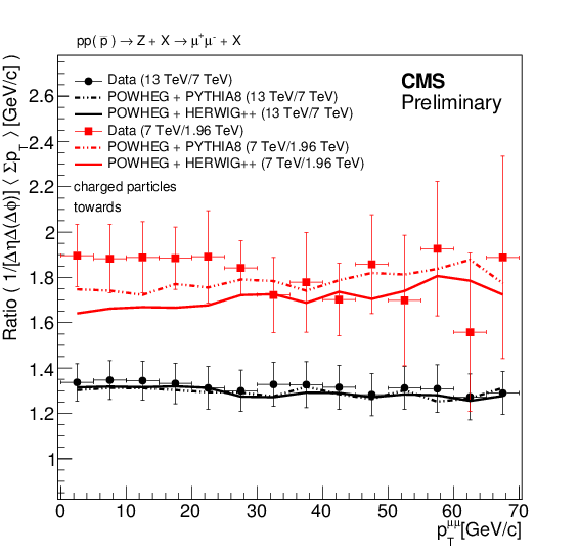
png pdf |
Figure 7-b:
Comparison of the UE activity measured at √s= 13 TeV with the measurements at 7 and 1.96 TeV, by the CMS and CDF experiments, in the towards region. The Figure shows the ΣpT density as a function of pTμμ. The measured data distributions are also compared with predictions of powheg + pythia8 and powheg + herwig++. Error bars represent the statistical and systematic uncertainties added in quadrature. |
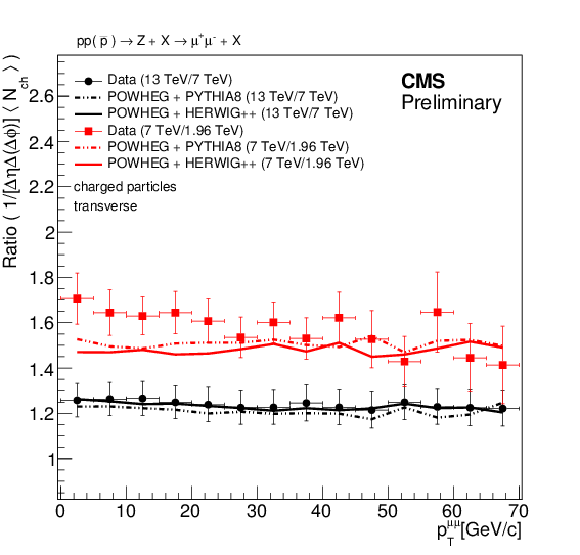
png pdf |
Figure 7-c:
Comparison of the UE activity measured at √s= 13 TeV with the measurements at 7 and 1.96 TeV, by the CMS and CDF experiments, in the transverse region. The Figure shows the particle density as a function of pTμμ. The measured data distributions are also compared with predictions of powheg + pythia8 and powheg + herwig++. Error bars represent the statistical and systematic uncertainties added in quadrature. |
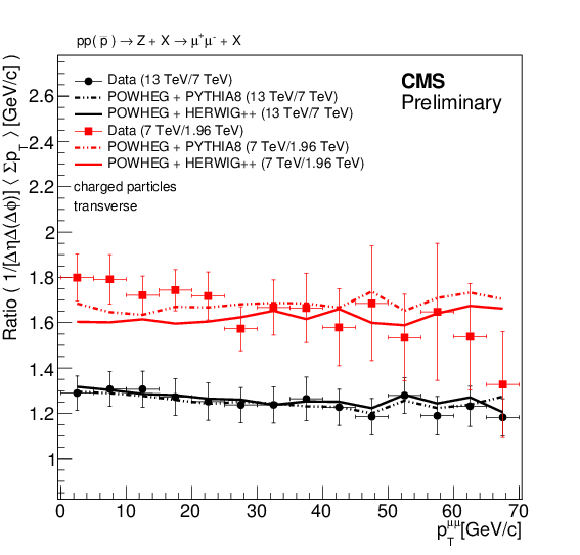
png pdf |
Figure 7-d:
Comparison of the UE activity measured at √s= 13 TeV with the measurements at 7 and 1.96 TeV, by the CMS and CDF experiments, in the transverse region. The Figure shows the ΣpT density as a function of pTμμ. The measured data distributions are also compared with predictions of powheg + pythia8 and powheg + herwig++. Error bars represent the statistical and systematic uncertainties added in quadrature. |
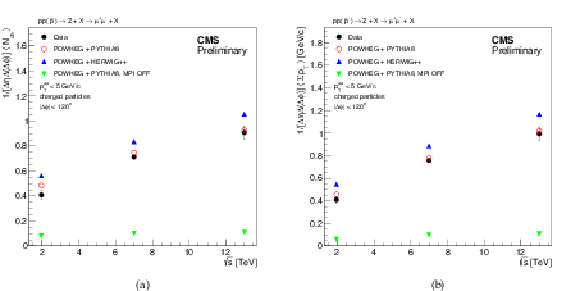
png pdf |
Figure 8:
(a) Particle density and (b) ΣpT density, with pTμμ< 5 GeV/c, as a function of centre-of-mass energy for data and predictions from simulations by powheg + pythia8 and powheg + herwig++. The predictions of powheg + pythia8 without MPI are also shown. Error bars represent the statistical and systematic uncertainties added in quadrature. |
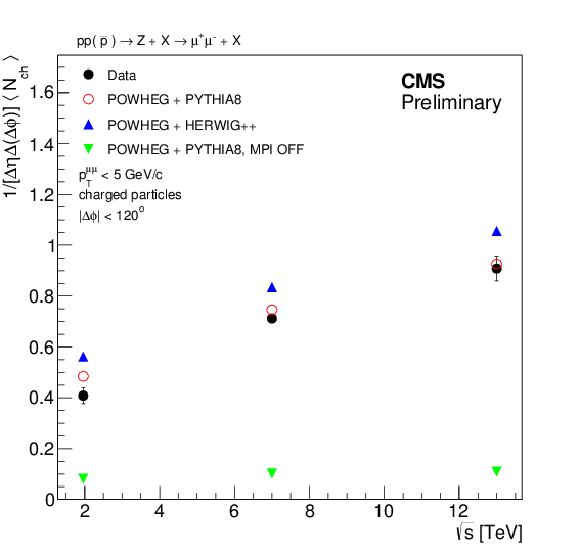
png pdf |
Figure 8-a:
Particle density, with pTμμ< 5 GeV/c, as a function of centre-of-mass energy for data and predictions from simulations by powheg + pythia8 and powheg + herwig++. The predictions of powheg + pythia8 without MPI are also shown. Error bars represent the statistical and systematic uncertainties added in quadrature. |
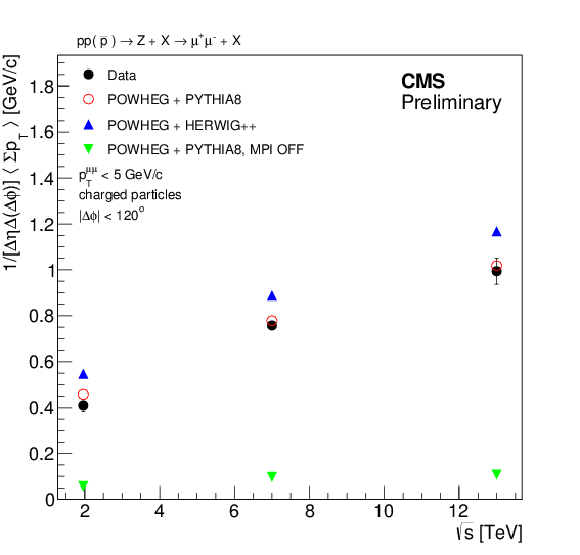
png pdf |
Figure 8-b:
ΣpT density, with pTμμ< 5 GeV/c, as a function of centre-of-mass energy for data and predictions from simulations by powheg + pythia8 and powheg + herwig++. The predictions of powheg + pythia8 without MPI are also shown. Error bars represent the statistical and systematic uncertainties added in quadrature. |
| Tables | |
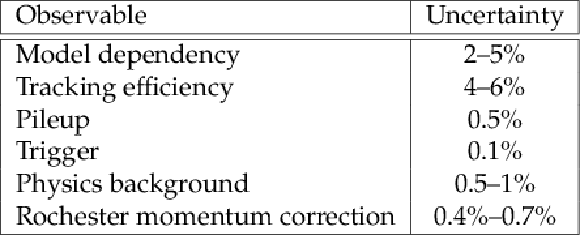
png pdf |
Table 1:
Summary of the systematic uncertainties on the particle and ΣpT density. |
| Summary |
| This article presents a measurement of the UE activity using inclusive Z-boson events at a centre-of-mass energy of 13 TeV. Analyzed data corresponds to an integrated luminosity of 2.1 fb−1. The UE activity, quantified in terms of particle and ΣpT densities, is measured as a function of the resultant pT of the two muons coming from the decay of the Z-boson. The distributions are corrected for detector effects and compared with various predictions. It is observed that madgraph and powheg, hadronized with pythia8 and CUET8PM1 tune, describe the measurements within 5%. The combination of powheg + herwig++ with tune EE5C, overestimates the measurements by 10-15%. The results obtained at 13 TeV are also compared with previous measurements at 1.96 and 7 TeV. The UE activity almost doubles, with logarithmic increase, as the collision energy increases from 1.96 to 13 TeV. Simulations nicely describe the increase in UE activity as the collision energy increases from 7 to 13 TeV but they underestimate the UE evolution from 1.96 to 7 TeV. Hence simulations need further improvements for UE modeling, especially in the energy dependence. The present measurement, in combination with previous results, will be important for the further optimization of the model parameters in various simulations. |
| References | ||||
| 1 | J. R. Gaunt, C.-H. Kom, A. Kulesza, and W. J. Stirling | Same-sign W pair production as a probe of double parton scattering at the LHC | EPJC69 (2010) 53--65 | 1003.3953 |
| 2 | CMS Collaboration | Search for new physics with same-sign isolated dilepton events with jets and missing transverse energy at the LHC | JHEP 06 (2011) 077 | CMS-SUS-10-004 1104.3168 |
| 3 | CMS Collaboration | Measurement of the Underlying Event Activity at the LHC with √s= 7 TeV and Comparison with √s= 0.9 TeV | JHEP 09 (2011) 109 | CMS-QCD-10-010 1107.0330 |
| 4 | CMS Collaboration | Measurement of the underlying event activity using charged-particle jets in proton-proton collisions at √s= 2.76 TeV | JHEP 09 (2015) 137 | CMS-FSQ-12-025 1507.07229 |
| 5 | CMS Collaboration | Measurement of the underlying event in the Drell-Yan process in proton-proton collisions at √s= 7 TeV | EPJC72 (2012) 2080 | CMS-QCD-11-012 1204.1411 |
| 6 | CMS Collaboration | Study of the underlying event, b-quark fragmentation and hadronization properties in ˉtt events | CMS-PAS-TOP-13-007(2013) | |
| 7 | CMS Collaboration | Underlying event measurement with ttbar+X events with p-p collision data at √s= 13 TeV | CMS-PAS-TOP-15-017(2015) | |
| 8 | ALICE Collaboration | Underlying Event measurements in pp collisions at √s= 0.9 and 7 TeV with the ALICE experiment at the LHC | JHEP 07 (2012) 116 | 1112.2082 |
| 9 | ATLAS Collaboration | Measurement of underlying event characteristics using charged particles in pp collisions at √s= 900 GeV and 7 TeV with the ATLAS detector | PRD83 (2011) 112001 | 1012.0791 |
| 10 | ATLAS Collaboration | Measurements of underlying-event properties using neutral and charged particles in pp collisions at 900 GeV and 7 TeV with the ATLAS detector at the LHC | EPJC71 (2011) 1636 | 1103.1816 |
| 11 | ATLAS Collaboration | Measurement of the dependence of transverse energy production at large pseudorapidity on the hard-scattering kinematics of proton-proton collisions at √s= 2.76 TeV with ATLAS | PLB756 (2016) 10--28 | 1512.00197 |
| 12 | ATLAS Collaboration | Measurement of distributions sensitive to the underlying event in inclusive Z-boson production in pp collisions at √s= 7 TeV with the ATLAS detector | EPJC74 (2014), no. 12 | 1409.3433 |
| 13 | CDF Collaboration | Studying the Underlying Event in Drell-Yan and High Transverse Momentum Jet Production at the Tevatron | PRD82 (2010) 034001 | 1003.3146 |
| 14 | T. Sjostrand and M. Van Zijl | A Multiple Interaction Model for the Event Structure in Hadron Collisions | PRD 36 (1987) 2019 | |
| 15 | L. Frankfurt, M. Strikman, and C. Weiss | Transverse nucleon structure and diagnostics of hard parton-parton processes at LHC | PRD 83 (2011) 054012 | 1009.2559 |
| 16 | R. Kumar, M. Bansal, S. Bansal, and J. B. Singh | New observables for multiple-parton interactions measurements using Z+jets processes at the LHC | PRD93 (2016), no. 5, 054019 | 1602.05392 |
| 17 | J. Alwall et al. | The automated computation of tree-level and next-to-leading order differential cross sections, and their matching to parton shower simulations | JHEP 07 (2014) 079 | 1405.0301 |
| 18 | S. Frixione, P. Nason, and C. Oleari | Matching NLO QCD computations with parton shower simulations: the POWHEG method | JHEP 11 (2007) 070 | 0709.2092 |
| 19 | K. Hamilton, P. Nason, and G. Zanderighi | MINLO: Multi-Scale Improved NLO | JHEP 10 (2012) 155 | 1206.3572 |
| 20 | F. Maltoni and T. Stelzer | MadEvent: Automatic event generation with MadGraph | JHEP 02 (2003) 027 | hep-ph/0208156 |
| 21 | J. Alwall et al. | MadGraph 5: Going Beyond | JHEP 06 (2011) 128 | 1106.0522 |
| 22 | T. Sjostrand, S. Mrenna, and P. Z. Skands | A Brief Introduction to PYTHIA 8.1 | CPC 178 (2008) 852 | 0710.3820 |
| 23 | CMS Collaboration | Event generator tunes obtained from underlying event and multiparton scattering measurements | EPJC76 (2016), no. 3, 155 | CMS-GEN-14-001 1512.00815 |
| 24 | GEANT4 Collaboration | GEANT4: A simulation toolkit | NIMA 506 (2003) 250 | |
| 25 | J. M. Campbell, R. K. Ellis, P. Nason, and G. Zanderighi | W and Z bosons in association with two jets using the POWHEG method | JHEP 08 (2013) 005 | 1303.5447 |
| 26 | M. Bahr et al. | Herwig++ physics and manual | EPJC 58 (2008) 639 | 0803.0883 |
| 27 | CMS Collaboration | The CMS experiment at the CERN LHC | JINST 3 (2008) S08004 | CMS-00-001 |
| 28 | CMS Collaboration Collaboration | Performance of CMS muon reconstruction in pp collision events at √s= 7 TeV | JINST 7 (2012) P10002 | 1206.4071 |
| 29 | CMS Collaboration | Description and performance of track and primary-vertex reconstruction with the CMS tracker | JINST 9 (2014) P10009 | CMS-TRK-11-001 1405.6569 |
| 30 | CMS Collaboration | Particle-Flow Event Reconstruction in CMS and Performance for Jets, Taus, and MET | CMS-PAS-PFT-09-001(2009) | |
| 31 | A. Bodek et al. | Extracting Muon Momentum Scale Corrections for Hadron Collider Experiments | EPJC72 (2012) 2194 | 1208.3710 |
| 32 | CMS Collaboration | CMS tracking performance results from early LHC operation | EPJC 70 (2010) 1165 | CMS-TRK-10-001 1007.1988 |
| 33 | G. D'Agostini | A Multidimensional unfolding method based on Bayes' theorem | NIMA 362 (1995) 487 | |
| 34 | CMS Collaboration | Measurement of Tracking Efficiency | CMS-PAS-TRK-10-002(2010) | |
| 35 | CMS Collaboration | PileUp Uncertainity | link | |

|
Compact Muon Solenoid LHC, CERN |

|

|

|

|

|

|